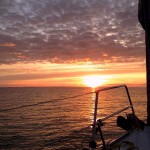 Anoxic (extremely low or no oxygen) zones occur naturally in the oceans. Typically they occur below areas of upwelling such as off Chile. A naturally occurring anoxic zone also occurs off the western U.S. coast from around 600-1200m. The occurrence of this zone reflects ocean circulation in the Pacific that results in a very old and deoxygenated water mass circulated to the our coast. Coastal upwelling compounds this phenomenon. Anoxic conditions can also result from anthropogenic effects such as the Gulf of Mexico Dead Zone, where nitrogen and phosphorous runoff from the Mississippi increase phytoplankton production which increases carbon input to the seafloor. This additional food increases the activity levels of organisms, increases reproduction which leads to more organisms, causes organisms to get bigger, attracts organisms to the area, etc. All of these lead to a net gain in respiration or O2 usage which strips the oxygen out of the water. Over the last few years an anoxic zone has emerged off the Oregon coast
Anoxic (extremely low or no oxygen) zones occur naturally in the oceans. Typically they occur below areas of upwelling such as off Chile. A naturally occurring anoxic zone also occurs off the western U.S. coast from around 600-1200m. The occurrence of this zone reflects ocean circulation in the Pacific that results in a very old and deoxygenated water mass circulated to the our coast. Coastal upwelling compounds this phenomenon. Anoxic conditions can also result from anthropogenic effects such as the Gulf of Mexico Dead Zone, where nitrogen and phosphorous runoff from the Mississippi increase phytoplankton production which increases carbon input to the seafloor. This additional food increases the activity levels of organisms, increases reproduction which leads to more organisms, causes organisms to get bigger, attracts organisms to the area, etc. All of these lead to a net gain in respiration or O2 usage which strips the oxygen out of the water. Over the last few years an anoxic zone has emerged off the Oregon coast
Chan et al. examine in Science this week provide a quantitative view into this emerging condition. In the past five decades anoxic conditions have not extended shallower than 600m (Fig 1a). From 2000-2005, hypoxic (low oxygen conditions) extended to shallow water by remained greater than 0.5 ml/L (green lines in Fig 1b). In 2006 conditions worsened (red lines, Figure 1c) with oxygen levels dropping to 0 ml/L. Submersible transects revealed zero fish, where prior transects contained diverse rockfish communities. Invertebrates exhibited almost complete mortality. The movie here is quite alarming (Frame grabs are below the fold) providing a striking visual contrast of the area pre- and post-anoxia.

Click for larger. Fig. 1. Dissolved oxygen profiles during the upwelling season (mid-April to mid-October) in the upper 800 m of the continental shelf and slope of Oregon (42.00 degrees N to 46.00 degrees N). (A) 1950 to 1999 from the World Ocean Database and Oregon State University archives (n = 3101 hydro- casts, blue). (B) (A) with additional data for 2000 to 2005 (n = 834 hydrocasts, green). (C) (A) and (B) plus data for 2006 (n = 220 hydrocasts, red). The black vertical line denotes the 0.5 ml l-1 threshol d. (I nsets) Over lapping locations of hydrographic (blue, green, and red) and remotely operated vehicle (black) stations through time and the 100-m and 1000-m isobaths.

Moribund or decomposing carcasses of Dungeness crabs (Cancer magister) and sunflower star (Pycnopodia helanthoides) after anoxoic event

Retracted Metridium farcimen individuals after anoxoic event

Development of putative sulphide-oxidizing bacterial colonies after anoxoic event not previously observed in 5 years of prior surveys.

Pre-anoxia survey showing aggregations of black rockfish (Sebastes melanops), quillback rockfish (Sebastes maliger), and tiger rockfish (Sebastes nigrocinctus)

Pre-anoxia, abundant macrobenthic invertebrates including giant sea cucumber (Parastichopus californicus) and giant plumose anemone (Metridium farcimen)






One Reply to “Oregon Dead Zone”
Comments are closed.